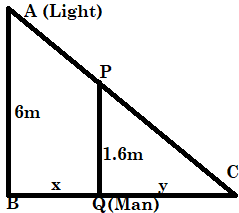
A man \[160cm\] tall, walks away from a source of light situated at the top of a pole \[6m\] high, at the rate of \[1.1m/{\mathop{\rm s}\nolimits} \]. How fast is the length of his shadow increasing when he is \[1m\] away from the pole?
Answer
552.3k+ views
Hint: In the given question, we have been given that there is a \[160cm\] or \[1.6m\] tall man. Then there is a light which is situated at the top of a pole which is \[6m\] in height. The man is traveling away from the pole at the speed of \[1.1m/{\mathop{\rm s}\nolimits} \]. We have to calculate the rate at which his shadow is increasing when he is \[1m\] away from the pole. For solving the question, we are going to first draw the position of the man and the light and try to form a recognizable shape from it. Then we are going to apply some basic concepts on it so as to calculate the answer of the same.
Formula Used:
In the given question, we are going to use the formula of differentiation, which is:
\[\dfrac{{d\left( {{x^n}} \right)}}{{dx}} = n{x^{n - 1}}\]
Complete step-by-step answer:
First, let us draw the position of the man and the light. And we are going to have a triangle after doing that. And let us name them as shown.

Now, C is the point where his shadow falls.
Clearly, \[\Delta ABC\] and \[\Delta PQC\] are similar.
Hence, \[\dfrac{{AB}}{{BC}} = \dfrac{{PQ}}{{QC}}\]
Putting in values,
\[\dfrac{6}{{x + y}} = \dfrac{{1.6}}{y}\]
Cross multiplying,
$\Rightarrow$ \[6y = 1.6x + 1.6y\]
Taking the like terms to one side,
$\Rightarrow$ \[6y - 1.6y = 1.6x\]
$\Rightarrow$ \[4.4y = 1.6x\]
Solving for \[y\],
\[y = \dfrac{{1.6}}{{4.4}}x = \dfrac{4}{{11}}x\] …(i)
Now, for the rate of change of shadow, we want \[\dfrac{{dy}}{{dt}}\]
So, differentiating (i) with respect to \[t\], we have
$\Rightarrow$ \[\dfrac{{dy}}{{dt}} = \dfrac{4}{{11}} \times \dfrac{{dx}}{{dt}}\]
Now, the speed of man is \[1.1m/s\], hence, \[\dfrac{{dx}}{{dt}} = 1.1\]
Thus, \[\dfrac{{dy}}{{dt}} = \dfrac{4}{{11}} \times 1.1 = 0.4m/s\]
So, the length of the shadow is moving at the pace of \[0.4m/s\] and is independent of the man's position from the light.
Note: So, for solving questions of such type, we first write what has been given to us. Then we write down what we have to find. Then we think about the formulae which contain the known and the unknown and pick the one which is the most suitable and the most effective for finding the answer of the given question. Then we put in the knowns into the formula, evaluate the answer and find the unknown. It is really important to follow all the steps of the formula to solve the given expression very carefully and in the correct order, because even a slightest error is going to make the whole expression awry and is going to give us an incorrect answer.
Formula Used:
In the given question, we are going to use the formula of differentiation, which is:
\[\dfrac{{d\left( {{x^n}} \right)}}{{dx}} = n{x^{n - 1}}\]
Complete step-by-step answer:
First, let us draw the position of the man and the light. And we are going to have a triangle after doing that. And let us name them as shown.

Now, C is the point where his shadow falls.
Clearly, \[\Delta ABC\] and \[\Delta PQC\] are similar.
Hence, \[\dfrac{{AB}}{{BC}} = \dfrac{{PQ}}{{QC}}\]
Putting in values,
\[\dfrac{6}{{x + y}} = \dfrac{{1.6}}{y}\]
Cross multiplying,
$\Rightarrow$ \[6y = 1.6x + 1.6y\]
Taking the like terms to one side,
$\Rightarrow$ \[6y - 1.6y = 1.6x\]
$\Rightarrow$ \[4.4y = 1.6x\]
Solving for \[y\],
\[y = \dfrac{{1.6}}{{4.4}}x = \dfrac{4}{{11}}x\] …(i)
Now, for the rate of change of shadow, we want \[\dfrac{{dy}}{{dt}}\]
So, differentiating (i) with respect to \[t\], we have
$\Rightarrow$ \[\dfrac{{dy}}{{dt}} = \dfrac{4}{{11}} \times \dfrac{{dx}}{{dt}}\]
Now, the speed of man is \[1.1m/s\], hence, \[\dfrac{{dx}}{{dt}} = 1.1\]
Thus, \[\dfrac{{dy}}{{dt}} = \dfrac{4}{{11}} \times 1.1 = 0.4m/s\]
So, the length of the shadow is moving at the pace of \[0.4m/s\] and is independent of the man's position from the light.
Note: So, for solving questions of such type, we first write what has been given to us. Then we write down what we have to find. Then we think about the formulae which contain the known and the unknown and pick the one which is the most suitable and the most effective for finding the answer of the given question. Then we put in the knowns into the formula, evaluate the answer and find the unknown. It is really important to follow all the steps of the formula to solve the given expression very carefully and in the correct order, because even a slightest error is going to make the whole expression awry and is going to give us an incorrect answer.
Recently Updated Pages
Master Class 11 Economics: Engaging Questions & Answers for Success

Master Class 11 English: Engaging Questions & Answers for Success

Master Class 11 Social Science: Engaging Questions & Answers for Success

Master Class 11 Biology: Engaging Questions & Answers for Success

Class 11 Question and Answer - Your Ultimate Solutions Guide

Master Class 11 Business Studies: Engaging Questions & Answers for Success

Trending doubts
10 examples of friction in our daily life

One Metric ton is equal to kg A 10000 B 1000 C 100 class 11 physics CBSE

Difference Between Prokaryotic Cells and Eukaryotic Cells

1 Quintal is equal to a 110 kg b 10 kg c 100kg d 1000 class 11 physics CBSE

Explain zero factorial class 11 maths CBSE

What is a periderm How does periderm formation take class 11 biology CBSE




